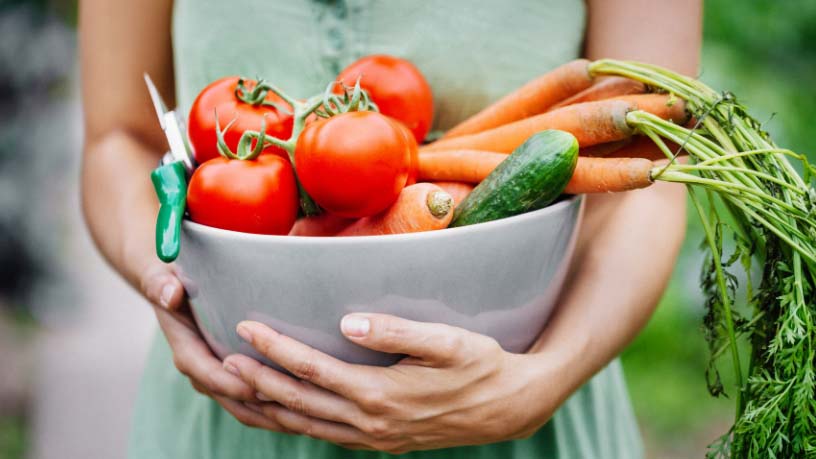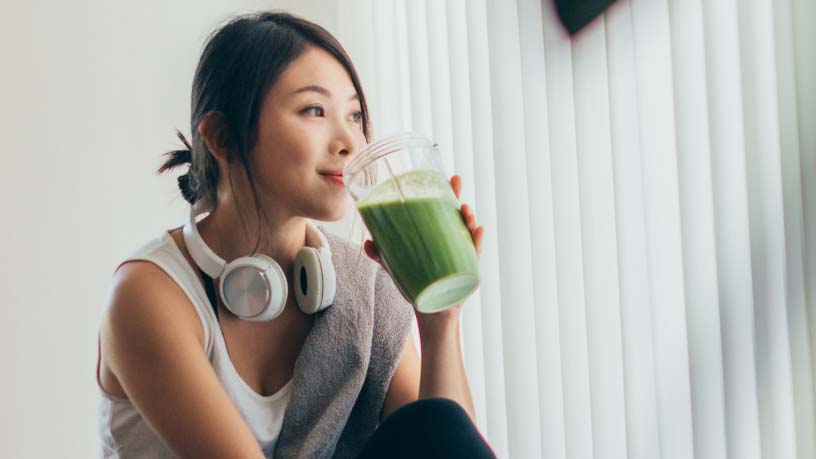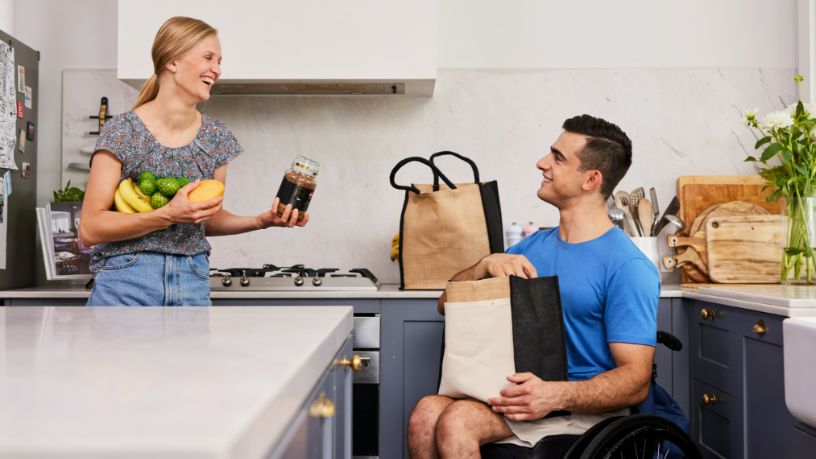Low GI foods can help you feel full and increase your energy levels.
On this page
Key takeaways
Low GI isn’t always the same as healthy.
Discover some simple food swaps to stabilise your blood sugar and keep you feeling fuller for longer.
Diets and food fads come and go, but occasionally a popular new trend can help us to understand how different types of food impact our bodies and how we can eat a little healthier.
What is GI?
The glycaemic index (GI) is a way of measuring how fast or slow a carbohydrate containing food is digested or broken down into the sugar called glucose. The GI acts as a tool to determine the quality of carbohydrate foods.
While ‘carbs’ became a bit of a dirty word some years ago, the reality is that we need carbohydrates to live and function at our very best.
Why do we need carbs?
When we eat a carbohydrate, it’s digested into glucose. This glucose is absorbed into the bloodstream and converted into energy that our body can use to carry out everyday functions we need to survive. In fact, carbohydrates have many uses.1
Carbs can:
- provide fuel for our brain
- provide fuel for our muscles during exercise
- keep our energy levels stable
- increase serotonin, a natural chemical that helps to improve our mood.
Some carbohydrates also contain a variety of vitamins and minerals important for overall wellbeing, and fibre which is crucial for gut health and keeping our bowels regular.
Do carbs lead to weight gain?
Carbs are a food group that is often demonised. Cutting carbs is often a strategy that people use to lose weight, and they often see success (at least initially). This is because carbohydrates hold on to water in our body, meaning if we cut carbs, people often see successful weight loss. However, this is largely water weight and not fat loss.
Carbohydrates are in lots of different types of food, including:
- grains (bread, rice, pasta, cereals)
- starchy vegetables (potato, sweet potato, corn)
- fruit (including fruit juice and dried fruit)
- dairy (such as milk and yoghurt, but not cheese)
- sweet foods (such as cakes, biscuits, chocolate)
- soft drinks.
What's the health link between the GI and carbs?
Quick digesting carbohydrates (foods high on the GI) rapidly increase our blood sugar levels before they fall or crash. This means we feel energised quickly, but soon after are lethargic and sleepy.
Slow digesting carbohydrates (low GI foods) release glucose into our blood stream gradually, leading to lower, more stable blood sugar levels. This means we feel fuller for longer and are less likely to overeat.
What are some of the health benefits of eating low GI foods?
Foods that are low on the GI can help prevent that energy high and slump so many of us get. They can help give you more sustained energy across the day.
In addition, low GI foods:
- tend to be higher in fibre, which keeps us feeling fuller for longer (this is important for the maintenance of a healthy weight and helps to prevent overeating)
- can help to reduce the risk factors of cardiovascular disease (such as high cholesterol, blood pressure and abdominal fat)2
- can decrease the risk of developing type 2 diabetes and can help in the management of diabetes. There is strong evidence that a healthy diet (including low GI carbs) and exercise can reduce the risk of developing type 2 diabetes for those who are high risk.2
What foods are high on the GI?
If you’re interested in reducing the amount of high GI foods you’re consuming, there are some foods to be aware of.
Fruit juice is high on the GI because the fibre has been removed. Fibre slows down the digestion of the carb into glucose. If you drink fruit juice, limit it to half a glass (125ml).
While most whole fruit is low on the GI, some fruits like watermelon, lychee and rockmelon are high, although still fine to include as part of a healthy diet. Remember, one serve is one cup of chopped fruit and we should aim for 2 serves per day.3
Alternative milks (like rice and oat milk) are higher on the GI then soy milk and dairy milk.
Standard brown rice is higher GI then longer grain rices such as basmati (white or brown) or Doongara rice.
Remember, just because these foods are higher GI does not mean they need to be avoided. Many high GI foods still provide nutrients, and a healthy diet is all about balance.
Does low fat mean low GI?
Foods that are higher in fat are not necessarily high on the GI.
Fats (both healthy and less healthy) can actually slow down how quickly a carbohydrate food can be digested and absorbed, as can protein and some acidic foods. These include:
- oils or oil spreads
- avocado
- nuts and seeds
- butter and cream
- red meat, chicken and fish
- legumes
- dairy
- lemon
- vinegar.
Is it easy to know what foods are low or high on the GI?
If you’re wanting to eat foods lower on the GI:
- look for the word 'whole' in the ingredients (such as wholegrain). This might be in foods including breads, wraps, rolls, crackers, crispbreads and cereal products
- choose carbs in their whole form. For example, eat whole fruit with the skin intact where possible instead of fruit juice or jam
- leave the skin on starchy vegetables (such as potatoes).
Easy high to low GI food swaps
If you want to eat foods that are lower on the GI, check out these easy, everyday food swaps for your breakfast, lunch, dinner and snacks.
Swap breakfast cereal (corn flakes, rice bubbles) for:
- whole rolled oats or porridge
- natural untoasted muesli
- multigrain Weetbix.
Swap white bread, rolls and wraps for:
- sourdough bread
- multigrain bread, rolls and wraps.
Multigrain rolls and wraps are a good option for a BBQ. Try switching them in for your sausage in bread, burger, or bacon and egg roll.
Swap white rice for:
- long grain rice such as basmati (white or brown).
Swap spreads or ‘toast toppers’, such as jam and honey, for:
- peanut butter (choose one with no added salt or sugar)
- Vegemite.
Swap chocolate biscuits or lamingtons (or desserts generally) for:
- homemade lower sugar cakes, loaves and muffins
- muesli or nut bars
- Milo with skim milk.
There are great ideas on the Heart Foundation’s online recipe bank. They use healthier swaps such as Greek yoghurt, almond meal and whole meal flour.
Swap pavlova for:
- pavlova topped with fresh fruit (not fruit in syrup) and low-fat Greek yoghurt, custard, or reduced fat cream.
Adding lower fat cream, yoghurt or custard (fat and/or protein) will lower the GI.
Swap boiled white potatoes without skin, or mashed potatoes for:
- potato salad (cooking and cooling the potatoes lowers the GI)
- potatoes roasted with skin on.
Swap chips or crackers with dips and cheese for:
- wholegrain crackers and homemade dip with avocado and lemon.
Swap fruit juice for:
- whole fruit such as mango, pear or cherries (eat the fruit skin when possible).
Note: Barramundi, chicken parmigiana, beef, seafood and avocadoes are naturally low on the GI.
Dinner tip: If you’re craving a parm or fish and chips for dinner, always serve with homemade chips or wedges roasted with the skin on. Use a healthy oil, such as olive or avocado oil, to help lower the GI.

At Bupa, trust is everything
Our health and wellbeing information is regularly reviewed and maintained by a team of healthcare experts, to ensure its relevancy and accuracy. Everyone's health journey is unique and health outcomes vary from person to person.
This content is not a replacement for personalised and specific medical, healthcare, or other professional advice. If you have concerns about your health, see your doctor or other health professional.
1Glycaemic Index Foundation. (2024). GI and carbohydrates. Glycaemic Index Foundation.
2Glycaemic Index Foundation. (2024). GI and heart disease. Glycaemic Index Foundation.
3Eat for health. (2024). The five food groups. Australian Government.
You might also like...
Vegetarian and plant-based diets: What’s the difference?
Food trends may come and go, but eating more plants and less meat might be here to stay.
Healthy breakfast ideas for people with food intolerances
Whether you’re avoiding dairy, gluten or even fructose due to intolerances, we’ve put together some easy breakfast ideas to help.
50 healthy food swaps
Small changes to your diet can have a big impact on your health. To make it easy, we’ve put together 50 healthier food swaps you can make for the whole family.
Can multivitamins fill gaps in your nutrition?
Supplements are everywhere, from entire supermarket aisles to ads on TV. But can supplements compensate for a poor diet or prevent you from getting sick?





